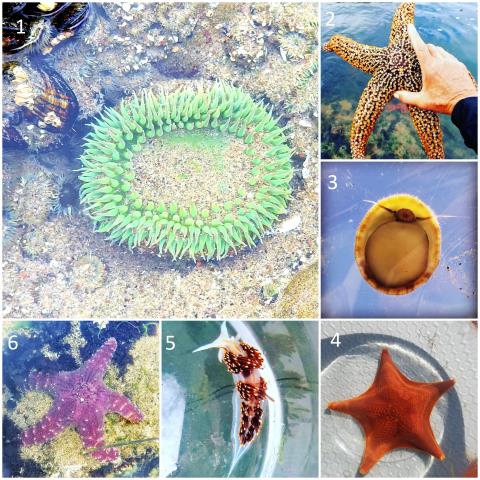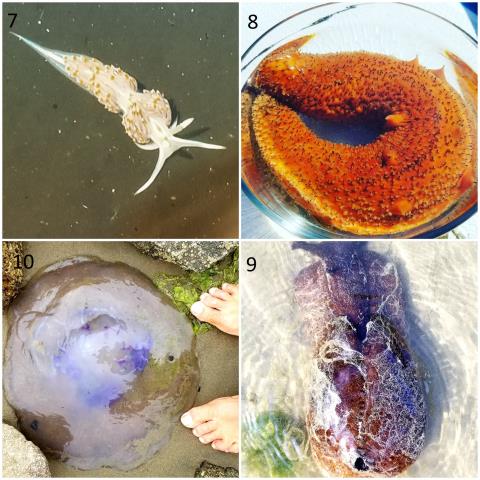Recently named one of the Best Small Towns in California by Country Living Magazine, the charming town of Morro Bay offers visitors some of the most breathtaking coastline and unspoiled open spaces in the state. But search just under the surface, or along Morro Bay beaches etched with tide pools, and find lingering living species that are uncommon to most—creatures that you cannot find everywhere. Here, kayaking and paddle boarding provide up close encounters with these underwater residents in their natural environment
"Morro Bay is a very biologically diverse place,” explains Mary Robinson, owner of Morro Bay Stand Up Paddleboarding. And she should know. Mary leads tours that focus on nature and animal life inside the Morro Bay harbor. “The harbor is not only home to a multitude of birds and marine mammals, but hundreds of species of the lesser known invertebrates, which are as biologically important."
Robinson documents what she finds below the surface and has hundreds of amazing images that capture their haunting beauty. Here are ten such creatures:
- The Giant Green Anemone
If you’ve ever had the pleasure of going “tide-pooling” in Morro Bay, you’ve undoubtedly seen the Giant Green Anemone clumped to the rocks. These invertebrates are usually a vivid green, as in the picture, and have numerous conical-shaped tentacles that surround an “oral disk” where their mouth is located. The tentacles deliver a sting that can immobilize small prey animals such as crabs, fish and sea urchins but is harmless to human beings.
Anemone clumped to the rocks. These invertebrates are usually a vivid green, as in the picture, and have numerous conical-shaped tentacles that surround an “oral disk” where their mouth is located. The tentacles deliver a sting that can immobilize small prey animals such as crabs, fish and sea urchins but is harmless to human beings. - The Giant Sea Star
This species of sea star lives along the western coast of North America, making its home on rocky shores near the low tide mark. They prey on mollusk and can grow as large as 24” in diameter. Collecting these beauties is prohibited by law except for research purposes. - Limpets
That funny looking yellowish brown round thing is actually a limpet, an aquatic snail with a shell that is broadly conical in shape and a strong, muscular foot. Using its muscular foot, the limpet is able to form such a tight bond to its home rock making it very difficult to pry off. The shell is shaped to protect it from crashing waves and strong coastal currents and prevents it from drying out in the sun. - The Bat Star
This amazing sea creature comes in many colors including the one pictured in bright red/orange. Also known as a sea bat, webbed star, and broad-disk star, this sea star species typically has five arms. You’ll notice the center disk is much wider than the stubby arms are in length. Although the bat star usually has five arms, it sometimes has as many as nine. - Opalescent Nudibranchs
Known for being one of the prettiest and most colorful species found under the surface in Morro Bay, these "sea slugs" eat hydroids and anemones. Its deep orange Cerrata (fingerlike projections), the creature’s body looks almost translucent. Some experts believe that nudibranchs' gaudy colors keep predators away. - Purple Star Fish
The beautiful purple starfish is part of the Ochre Sea Stars family. These are relatively large sea stars, with five arms and a rough surface and short spines arranged in wavy patterns. Most of them are either purple or orange (ochre), and there is no good hypothesis to explain this color polymorphism. - The Morro Bay Aeolid Nudibranc Sea Slug
These slimy land slugs are very delicate and rarely seen. The one in the photo looks completely white but they usually have orange rhinophores, white gills, and pointed orange and brown tipped dorsal papillae, some of which have forked tips.
usually have orange rhinophores, white gills, and pointed orange and brown tipped dorsal papillae, some of which have forked tips. - The Giant California Sea Cucumber
The giant California sea cucumber is also known as the Red sea cucumber and can be found in the waters from the Gulf of Alaska to Baja California. It lives in the low intertidal zone, most abundant in areas with moderate current with cobbles, boulders or bedrock like we have in Morro Bay. - The California Sea Hare
The California sea hare is purple with two pairs of tentacles on the top of its head, one pair near the mouth and the other behind the eyes. Sea hares may lay up to eighty million eggs apiece but most of these are eaten by predators. They have a sucker-like mouth and a large muscular foot on the underside of the body. - Moon Jelly
The moon jelly got its name from their translucent, moonlike circular bells. Instead of long, trailing tentacles like other jelly fish, moon jellies have a short, fine fringe (cilia) that sweeps food toward the mucous layer on the edges of the bells. When these creatures feed extensively on crustaceans, they turn pink or lavender. Moon jellyfish do not have strong enough stinging power to penetrate through the human skin, but if you happen to get brushed by one, you will feel a minor stinging sensation.
These are just some of the amazing creatures you will find when you visit Morro Bay. If you see them in the wild, feel free to capture them with a photo but please don’t disturb them. They belong in the sea. Just remember, when an ecosystem is disturbed, nature changes and it’s rarely for the better.
For more travel information, follow Morro Bay Tourism on Facebook, Instagram, Twitter and Pinterest or visit www.morrobay.org.